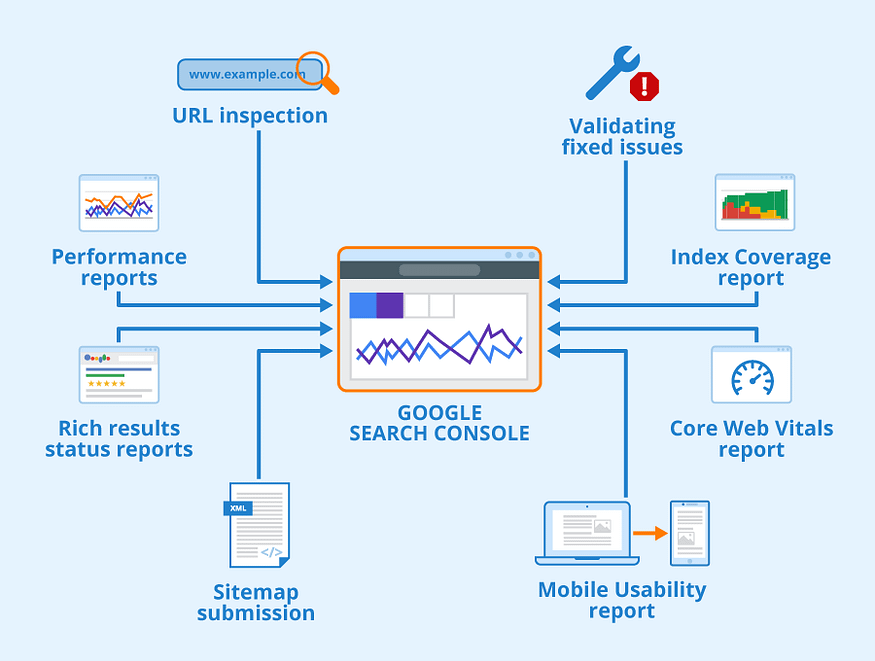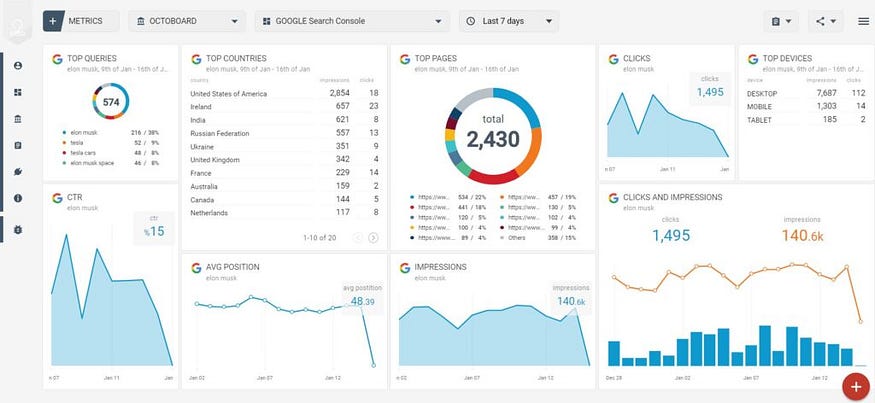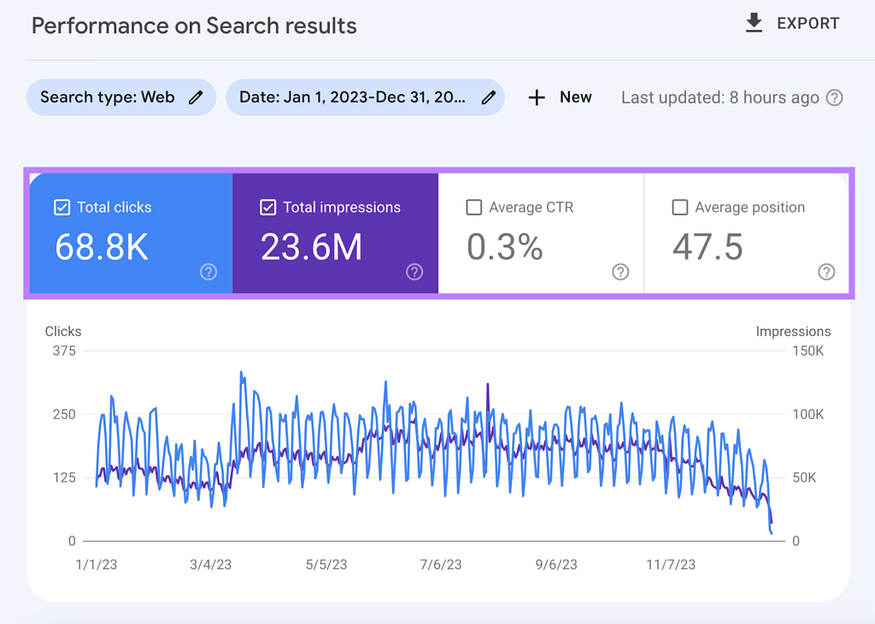How to Use Google Search Console to Improve Your SEO
Google Search Console is a free service that helps website owners monitor and manage their site’s performance in Google Search. It provides insights into how your site is seen by Google. Some of the main features include:
- Performance Data: Find out how many clicks and impressions your pages receive.
- Indexing Information: See which of your pages are indexed by Google and identify any issues.
- Search Queries: Discover what people are searching for to find your site.
- Technical Alerts: Get notified about security problems, crawling errors, or other issues.

By using GSC, you can understand where your website is succeeding and where it might need improvement. This information is valuable for anyone trying to improve their website’s search engine optimization (SEO).
Setting Up Google Search Console
Before you can use the power of Google Search Console, you first need to set it up correctly. Here’s a step-by-step guide to get started:
- Sign In to Google Search Console:
Visit Google Search Console and sign in using your Google account. If you don’t have one, you’ll need to create one. - Add Your Website as a Property:
Once logged in, click on the “Add Property” button. You will be asked to enter your website’s URL. It’s important to enter the exact URL that people use to reach your website (for example, including “https://” if that is used). - Verify Your Ownership:
Google needs to know that you are the rightful owner of the website. There are several ways to do this:
- HTML File Upload: Download a file from Google and upload it to your website.
- HTML Tag: Add a special meta tag to the homepage of your website.
- Google Analytics: If you already use Google Analytics and have administrative access, you can verify using your Analytics account.
- DNS Record: Add a DNS record through your domain provider.
- Pick the method that is easiest for you and follow the instructions provided by Google.
- Submit Your Sitemap:
A sitemap is like a roadmap of your website. It tells Google which pages exist on your site. After verifying your ownership, submit your sitemap (usually named sitemap.xml) to help Google crawl your site more efficiently.

Taking these steps will set you up with Google Search Console so that you can start receiving useful data about your website. The process is quick and can be completed in about 15–20 minutes for a small website.
Why Setting Up GSC Is Important
Many website owners struggle with low traffic and poor search rankings. By setting up GSC, you can start to understand why your website might not be performing as well as it could. It alerts you to issues that might be keeping your pages from ranking and shows you areas where you can improve. In short, GSC is a guide to help your website become more visible on Google.
Understanding the Google Search Console Dashboard
Once you’ve set up Google Search Console, the next step is to familiarize yourself with the dashboard. The dashboard is the control panel where all the data and reports are available.
Overview of the Dashboard
When you log in to GSC, you will see several key sections:
- Performance: This section shows data on clicks, impressions, click-through rates (CTR), and the average position of your website in search results.
- Coverage: This section displays how many pages have been indexed by Google and highlights any errors, such as pages that could not be crawled.
- Experience: Here, you can see information about how users interact with your site. This can include mobile usability and other user experience factors.
- Enhancements: This report is particularly useful if you use structured data (information that helps Google understand the content of your pages better). It shows errors or suggestions related to rich results like recipes, articles, or product information.

Navigation and Key Reports
- Performance Report:
The performance report is where most website owners will spend a lot of time. It gives you a detailed view of how well your website is doing in Google search. You can see which pages are getting the most clicks, which keywords bring in traffic, and the overall trends in your site’s performance over time. - Coverage Report:
The coverage report is critical for technical SEO. It shows you which pages Google has successfully indexed and which pages have errors. Errors might include pages that are not found (404 errors) or pages that encounter server errors (5xx errors). Regularly reviewing this report ensures that all important pages on your site are accessible to Google. - Mobile Usability Report:
In the mobile-first era, this report helps you ensure your website works well on mobile devices. It identifies any issues that mobile users might face, like text that is too small or clickable elements that are too close together. - Enhancements and Rich Results:
These reports show you if you have any issues with structured data. Structured data can help your site appear with rich results (like star ratings or additional information) in search results, which can improve your click-through rate.
Understanding these reports is key to effectively using Google Search Console. The more time you spend exploring the dashboard, the more familiar you will become with the nuances of your site’s performance.
Also Read: Is Digital Marketing the Right Career for You?
Monitoring Your Website’s Performance
The main purpose of Google Search Console is to help you monitor your website’s performance in Google Search. In this chapter, we will break down the most important parts of the performance data and explain how to use them to improve your SEO.
The Performance Report in Detail
The performance report shows several useful metrics:
- Total Clicks:
This number shows how many times users clicked on your site’s link in the search results. A higher number means more visitors found your site interesting. - Total Impressions:
Impressions count how many times your site appears in search results. Even if users don’t click, high impressions show that your pages are visible to many people. - Average Click-Through Rate (CTR):
The CTR is the percentage of impressions that turn into clicks. If your CTR is low, it may be an indication that your title tags and meta descriptions need improvement to entice users to click. - Average Position:
This metric shows your site’s average ranking for the searched keywords. A lower number (closer to 1) is better, as it means your pages are ranking higher in search results.

Analyzing Search Queries
Under the performance report, you can see what keywords people are using to find your site. This can reveal surprises about what your audience is interested in. For example, you might discover that a post you wrote months ago is suddenly popular. Understanding these search queries can help you tailor your content to better meet user needs.
Filtering and Comparing Data
Google Search Console allows you to filter data by country, device type, and date range. This feature is useful to determine trends over time. For instance:
- Country Filter: Learn if most of your traffic comes from a particular country.
- Device Filter: See if users access your site mostly from desktops, tablets, or smartphones.
- Date Range Comparison: Compare your performance metrics week by week or month by month to see if your changes are working.
Using the Data to Improve SEO
Once you have an understanding of your performance data, you can use it to make improvements. Here are some practical steps:
- Optimize High-Impression Keywords: If you see keywords with lots of impressions but few clicks, consider updating your title tags and meta descriptions.
- Focus on Well-Performing Pages: Identify the pages that are already receiving clicks and try to improve their ranking by adding internal links and updating the content.
- Identify Low-Performing Content: Look at pages with very low CTRs or poor average positions. Analyze what might be wrong (such as outdated content or poor title tags) and work on improving them.
By regularly checking the performance report, you stay on top of how your website is doing and can make data-driven decisions to boost your rankings.
Enhancing Your Site’s Index Coverage
Index coverage is a vital part of SEO. It is not enough for Google to know your website exists; Google needs to be able to crawl and index your pages correctly. In this chapter, we cover the Coverage report in Google Search Console and how to address common issues.
To know more about Google Search Console Read our Article



Comments
Post a Comment